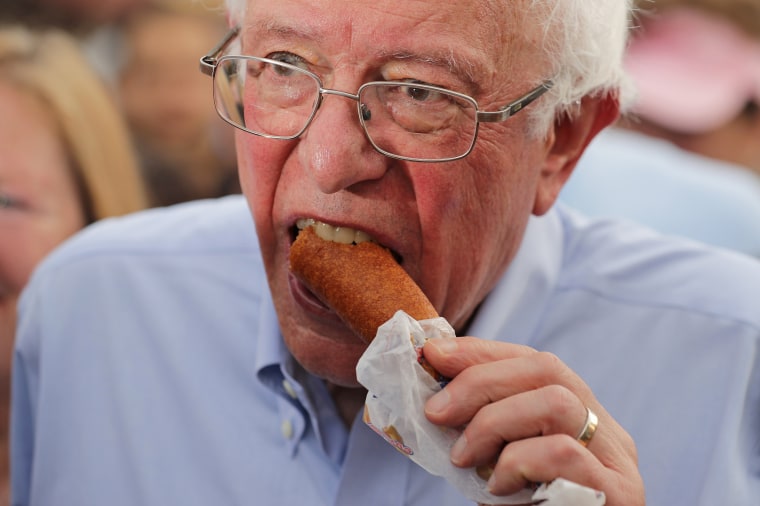There is something innately American in loving the sight of a well-dressed politician opening his or her mouth wide for a corn dog, head bent, eyes narrowed. There is no way to do this politely — that’s the point.
The Iowa State Fair is not a polite endeavor. It’s a deep-fried, sugared, high fat, carbo-loaded smorgasbord of low-brow bacchanalia, washed down with a cheap beer whose color and consistency resembles what later happens in a port-o-potty over by a row of Allis Chalmers tractors.
The quadrennial gauntlet of the Iowa State Fair is a masochistic tradition we force on politicians and the journalists in their wake. They come to my state with their buttoned-up shirts, sleeves rolled, standing on stages lined in bales of hay in a heat and humidity that feels like being strangled by a sentient and angry cotton candy. They shake hands with shorts-clad families, gawk at a cow made entirely of butter, showing obsequious respect to the gods of corn, soy, dairy and pork.
It’s a silly show that happens in bold bright colors amid the twirling motions of rides, the gamey smells of hot humans, large pigs and the heavy hot grease of fried snickers, fried Oreos, fried beer, fried everything.
Last year, I went with a friend who hadn’t been to the fair before. We walked inside the gates and immediately paid to see the world's smallest horse. According to the blaring, prerecorded promotional loop: “He’s teeny! He’s tiny! He’s the world’s smallest horse! Smaller than some breeds of dogs.” It cost $5 to take a peek at him, by peering over a tarp-covered fence; he was indeed small. I’d do it again because, at a fair, what’s money? And what’s fun and what’s important is suddenly and delightfully inverted.
After the tiny horse, I took my friend to eat a pickle dawg, my favorite fair food. It’s a pickle coated in cream cheese — plain or spicy — wrapped in ham or salami and then it can be deep-fried. And why not? Spicy cream cheese it and deep fry it. Then, after that, pork chops, then deep-fried mac and cheese, red velvet funnel cake, cups of cold milk, free hard-boiled eggs on a stick, which we ate while we took our turn in front of a whole display of figurines shaped out of butter.
There are entire families who never spend money at the fair, who go for the free pens and notebooks, and nibble on free food. They eat lunches of Doritos and peanut butter and jelly sandwiches from coolers in their vans — an anemic kind of a tailgate. It’s a scarcity mentality born of the Midwest and an existence coaxed from a land that is just as hard and as beautiful as the people who work it. But the fair is about abundance, celebrating the fullness of the land before the work of harvest.
Begun in the 19th century, fairs were primarily about promoting the agricultural industry — an occasion when farmers and ranchers could display their bounty. As our nation moved toward industry over agriculture, the processed foods and the mechanized rides were displayed side-by-side with large cows, organic tomatoes and gigantic pumpkins. Now you can see both buggy competitions and stock car racing, a topsy-turvy clash of what we were and what we are as a country.
As fairs were becoming popular in America, Mikhail Bakhtin came up with his literary theory of the carnival, the world where kings parade as commoners and commoners become king, where low is high and high is low and heaven and hell meet. This still happens at the Iowa State Fair: We make our politicians, come sweat all over bales of hay. Here, there is no scallop sashimi with Meyer lemon confit, just fried Snickers. The veil between spectator and performer is ripped aside; as politicians speak, hecklers walk by. This year, as Bernie Sanders spoke to a crowd, a man in a MAGA hat walked by and yelled, “Feel the Bern in your pocket.”
Bakhtin could have been writing about the Iowa State Fair when he observed that the carnival “crowns and uncrowns, inverts rank, exchanges roles, makes sense from nonsense and nonsense of sense."
It’s a world where butter cows make more sense than reserved tubs of margarine. Where it makes sense to put something called a Carmellow on a stick, because why not? The nonsense — the indulgence — is the point, and it means something to celebrate and indulge in a place of restraint and economy, where life is hard, and rural towns are shrinking and hospitals are closing.
It’s easy to feel exhausted of the spectacle. And year after year, we ask why Iowa, why this place? Why this fair? Why these butter cows? But the answer lies in the pageantry, the sweat, the heat, the gamey smell of your next president’s armpits as they delicately bite a pork chop and glad hand a farmer.



